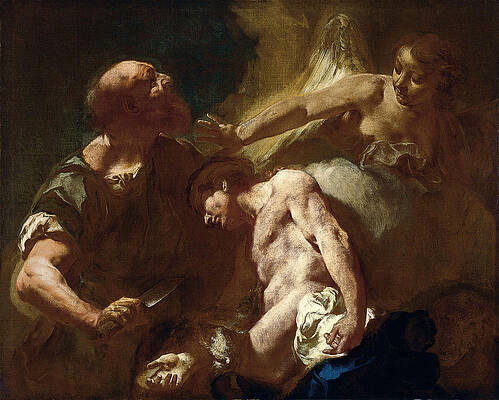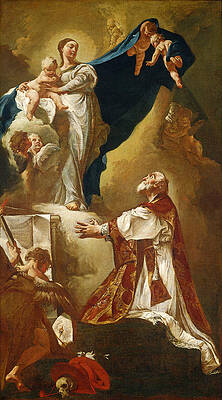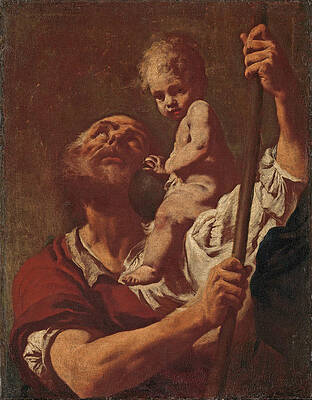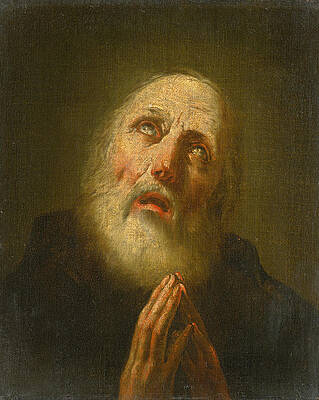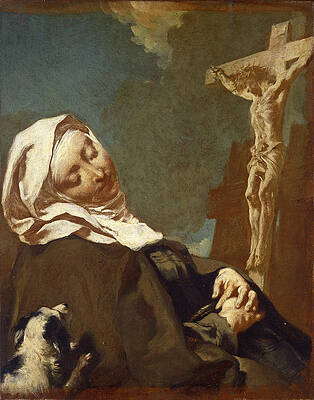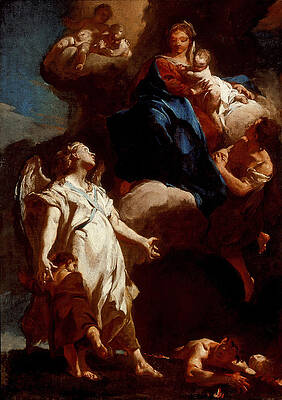Giovanni Battista Piazzetta
Paintings
Portrait of Giulia Lama
Saint Theresa in Ecstasy
Madonna and Child Appearing to Saint Philip Neri
God The Father
Portrait of a Hunter
Saint Christopher Carrying the Infant Christ
Saint Francis of Paula
Saint Margaret of Cortona
The Virgin Appearing to the Guardian Angel
The Education of the Virgin

Portrait of a Young Woman in Profile with a Mask in her Right Hand
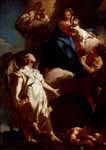
The Virgin Appearing to the Guardian Angel



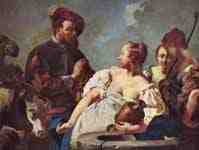
Drawings
A Portrait of Rosa with a Shoulder Stick
Self-portrait
Feeding the Dog
Girl with a Hen
Boy with an Egg, Girl with a Hen, and a Watching Woman


Fine Art Prints | Greeting Cards | Phone Cases | Lifestyle | Face Masks | Men's , Women' Apparel | Home Decor | jigsaw puzzles | Notebooks | Tapestries | ...
Saint Theresa in Ecstasy
Giovanni Battista Piazzetta (also called Giambattista Piazzetta or Giambattista Valentino Piazzetta) (February 13, 1682 or 1683 – April 28, 1754) was an Italian Rococo painter of religious subjects and genre scenes.
Biography
Piazzetta was born in Venice, the son of a sculptor Giacomo Piazzetta, from whom he had early training in wood carving. Starting in 1697 he studied with the painter Antonio Molinari. By Piazzetta's account, he studied under Giuseppe Maria Crespi while living in Bologna in 1703–05, although there is no record by Crespi of formal tutelage. Thanks to Crespi, Carlo Cignani's influence reached Piazzetta. Piazzetta did find inspiration in Crespi's art, in which the chiaroscuro of Caravaggio was transformed into an idiom of graceful charm in his pictures of common folk. He was also greatly impressed by the altarpieces created by another Bolognese painter of a half-century earlier, Guercino.
Around 1710, he returned to Venice. There he won recognition as a leading artist despite his limited output and his unassuming nature, but he ultimately was less patronized, both in Venice and especially abroad, than two other eminent stars in Venetian late-Baroque/Rococo, Ricci and Tiepolo. yet Piazzeta's range of topics was broader than that of these artists; Tiepolo, for example, never painted genre paintings and restricted himself to grand history and religious altarpieces. Ricci and Tiepolo had a luminous palette and facile ease that allowed them to carpet meters of ceiling with frescoes, although with a superficiality and glamor that is absent from Piazzetta's darker and more intimate depictions. Nonetheless,Tiepolo, who collaborated with Piazzetta on some projects, was greatly influenced by the older artist; in turn, the luminosity and brilliance of Tiepolo's palette influenced Piazzetta in his later years.
Piazzetta created an art of warm, rich color and a mysterious poetry. He often depicted peasantry, even if often in a grand fashion. He was highly original in the intensity of color he sometimes used in his shadows, and in the otherworldly quality he gave to the light which throws part of a composition into relief. The gestures and glances of his protagonists hint at unseen dramas, as in one of his best-known paintings, The Soothsayer (1740, now in Gallerie dell'Accademia, Venice). He brought similar elusiveness to works of a religious nature, such as the Sotto in su Glory of St. Dominic in the Church of Santi Giovanni e Paolo.
Also notable are his many carefully rendered drawings of half-length figures or groups of heads. Usually in charcoal or black chalk with white heightening on gray paper, these are filled with the same spirit that animates his paintings, and were purchased by collectors as independent works. He also produced engravings.
In 1750 Piazzetta became the first director of the newly founded Accademia di Belle Arti di Venezia, and he devoted the last few years of his life to teaching. He was elected a member of the Bolognese Accademia Clementina in 1727. Among the painters in his studio were Domenico Maggiotto, Francesco Dagiu (il Capella), John Henry Tischbien the Elder, Egidio Dall'Oglio, and Antonio Marinetti.[1] The engraver Marco Pitteri was affiliated with his studio, and engraved many of his works.[2] Among younger painters who emulated his style are Giulia Lama, Federico Bencovich, and Francesco Polazzo (1683–1753). He died in Venice on April 28, 1754.
Selected works
St.James Led to Matyrdom (1717) Chiesa di San Stae, Venice.
Madonna and child appearing to St Philip Neri (1725-7)[3]
Glory of St.Dominic (1725–1727) Chiesa di Santi Giovanni e Paolo, Venice.
Ecstasy of St.Francis (1732)
Assumption (1735)
St. Margaret of Cortona (1737) National Gallery Art, Washington DC [2]
Sacrifice of Isaac, (after 1735, unfinished) [3]
Rebecca at the well, c 1740
Fortune Teller(1740)
The Pastoral (1739–41)
Notes
Spike, JT. p181
Carlo Goldoni e Venezia nel secolo XVIII.(1882) Ferdinando Galanti, page 400.
originally Santa Maria della Fava, Venice, and now National Gallery of Art, Washington DC.[1]
References
Encyclopædia Britannica (1990)
Britannica online
Wittkower, Rudolf (1993). "19". In Pelican History of Art. Art and Architecture Italy, 1600-1750. 1980. Penguin Books Ltd. pp. 481–82.
John T Spike (1986). Centro Di, Kimball Museum of Art, Fort Worth, Texas, USA, ed. Giuseppe Maria Crespi and the Emergence of Genre Painting in Italy. p. 181.
----
Fine Art Prints | Greeting Cards | Phone Cases | Lifestyle | Face Masks | Men's , Women' Apparel | Home Decor | jigsaw puzzles | Notebooks | Tapestries | ...
----
Artist
A - B - C - D - E - F - G - H - I - J - K - L - M -
N - O - P - Q - R - S - T - U - V - W - X - Y - Z
Retrieved from "http://en.wikipedia.org/"
All text is available under the terms of the GNU Free Documentation License


